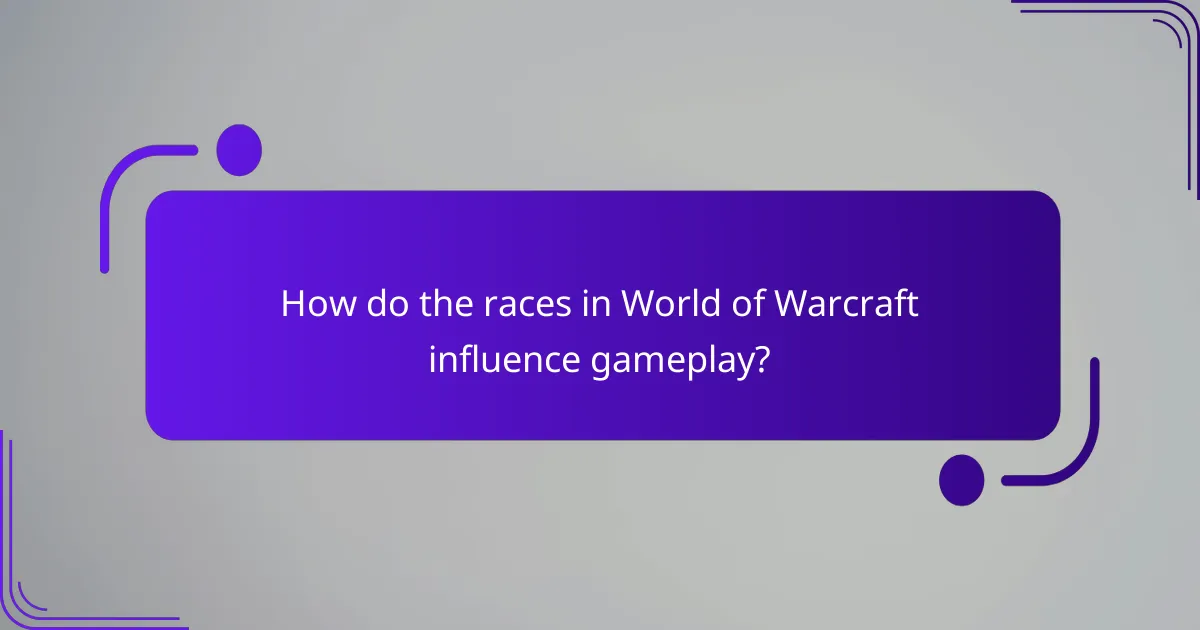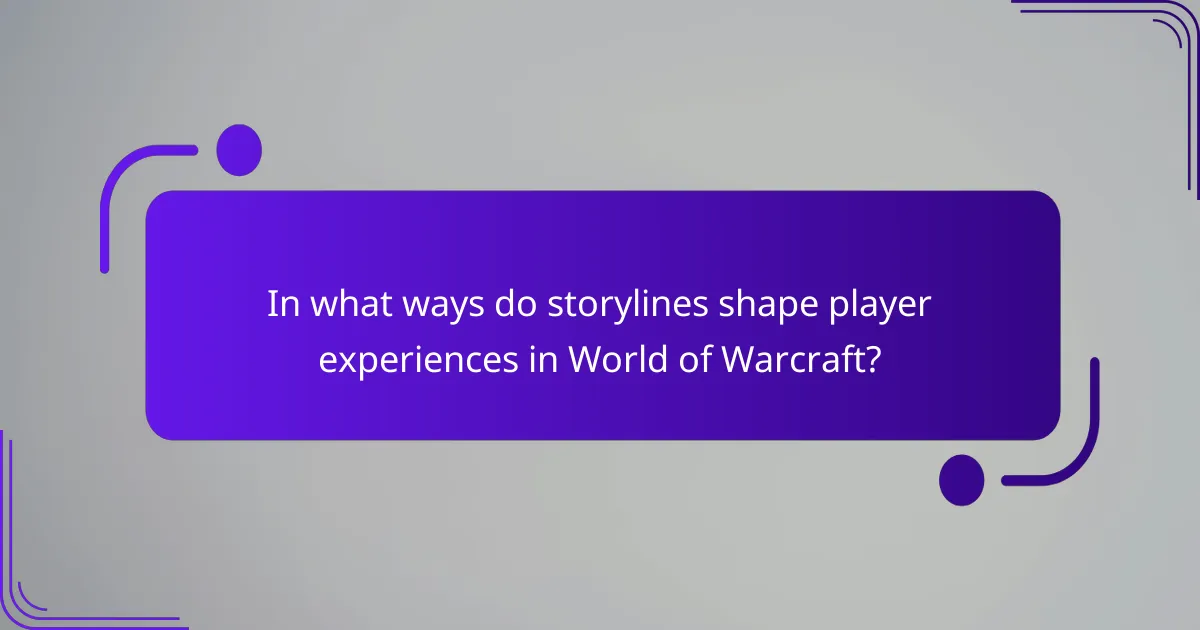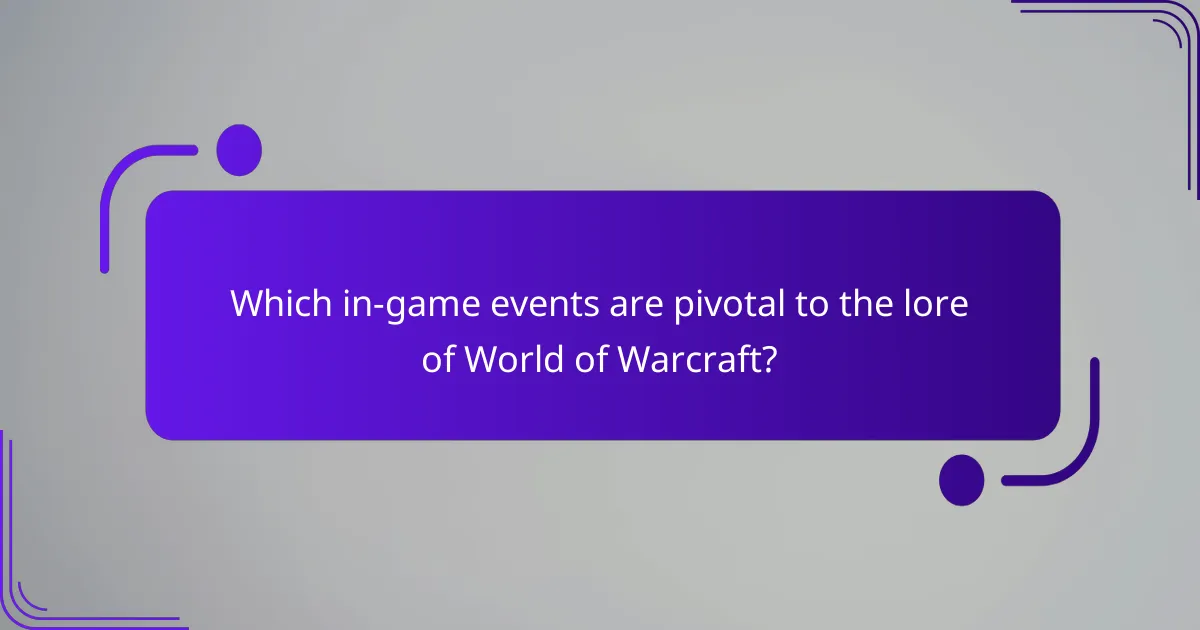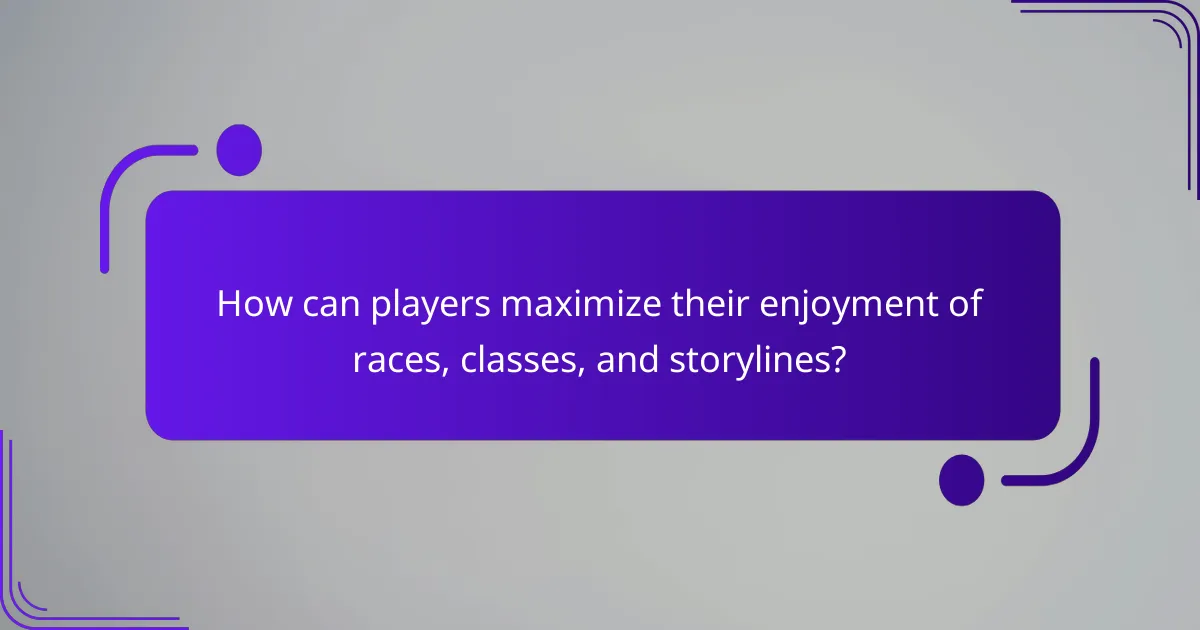Choosing the right race and class in World of Warcraft can significantly enhance your gameplay experience. This article explores the unique abilities of various races, the distinct gameplay styles offered by twelve classes, and the immersive storylines that shape player engagement. Understanding these elements can lead to more effective character builds and deeper connections within the game’s expansive lore.

How do the races in World of Warcraft influence gameplay?
The races in World of Warcraft significantly influence gameplay by providing unique abilities and traits. Each race offers distinct advantages that affect class selection and playstyle. For example, Night Elves have agility bonuses and stealth capabilities, enhancing their effectiveness as hunters. Meanwhile, Orcs possess racial abilities that boost melee damage and endurance, making them formidable warriors. This diversity in racial attributes encourages players to strategize their character builds, impacting both individual and group dynamics in quests and battles.
What are the defining characteristics of each race?
Each race in World of Warcraft has unique characteristics that define their abilities and lore.
| Race | Defining Characteristics | Unique Traits |
|—————|————————————————|————————————-|
| Humans | Versatile and adaptable, skilled in diplomacy | Strong leadership qualities |
| Orcs | Fierce warriors with strong tribal culture | Connection to shamanistic powers |
| Night Elves | Agile and stealthy, deeply connected to nature | Immortality and ancient wisdom |
| Dwarves | Resilient and sturdy, expert craftsmen | Mastery of engineering and mining |
| Undead | Undead beings with dark magic | Ability to raise the dead |
| Draenei | Noble and spiritual, with advanced technology | Unique healing abilities |
Which races are most popular among players in different regions?
The most popular races among players in different regions of World of Warcraft include Humans, Night Elves, and Orcs. In North America, Humans are favoured for their versatility. In Europe, Night Elves attract players with their unique lore and aesthetics. In Asia, Orcs are popular due to their strong warrior culture. Each race offers distinct attributes that appeal to various play styles.
How do racial abilities affect class choice and strategy?
Racial abilities significantly influence class choice and strategy in World of Warcraft. Each race has unique abilities that enhance specific class roles, impacting gameplay and synergy.
For example, Night Elves possess Shadowmeld, which provides stealth, benefiting classes like Rogues and Hunters. Orcs have Blood Fury, increasing their attack power, making them ideal for melee classes such as Warriors and Rogues.
Additionally, the choice of race can dictate playstyle. For instance, Dwarves’ Stoneform ability offers defensive advantages, favouring tank classes. Conversely, Draenei’s Gift of the Naaru provides healing, supporting caster classes effectively.
Ultimately, understanding racial abilities allows players to craft strategies that maximize their character’s strengths and complement team dynamics.
What unique lore accompanies each race?
Each race in World of Warcraft has a rich lore that shapes their identity and culture. For instance, the Night Elves are deeply connected to nature and the Well of Eternity, while Orcs have a history of honour and conflict stemming from their shamanistic roots. The Dwarves, known for their craftsmanship, are descendants of the Titans, which influences their technology and society. Humans, with their adaptability and ambition, have a lore rooted in the rise and fall of kingdoms. Each race’s unique attributes, such as the Draenei’s connection to the Light or the Forsaken’s struggle with their undead nature, further enrich their narratives. This intricate lore enhances gameplay and immerses players in the world.

What classes are available in World of Warcraft and how do they vary?
World of Warcraft features twelve distinct classes, each offering unique gameplay styles and abilities. These classes include Warrior, Paladin, Hunter, Rogue, Priest, Death Knight, Shaman, Mage, Warlock, Monk, Druid, and Demon Hunter.
Each class varies in its role within the game, such as damage dealing, healing, or tanking. For instance, Warriors excel in melee combat, while Mages specialise in ranged spellcasting. Unique attributes, like the Druid’s shapeshifting ability, further differentiate gameplay experiences.
Classes also have diverse talent trees, allowing players to customise their skills and playstyle. This variability enhances strategic depth and personal expression in character development. Additionally, expansions introduce new abilities and class mechanics, keeping the gameplay fresh and engaging.
Which classes are best suited for beginners versus experienced players?
For beginners, classes like Hunter and Paladin are ideal due to their straightforward mechanics. Experienced players may prefer classes like Rogue or Warlock, which offer advanced strategies and depth.
| Class | Best Suited For | Key Attribute |
|————-|——————-|————————–|
| Hunter | Beginners | Simple pet mechanics |
| Paladin | Beginners | Versatile playstyle |
| Rogue | Experienced | High skill ceiling |
| Warlock | Experienced | Complex resource management|
How do class specializations enhance gameplay diversity?
Class specializations significantly enhance gameplay diversity by providing unique abilities and playstyles. Each specialization alters how players engage in combat, support allies, or explore the world. This variety encourages different strategies and team compositions, making each encounter distinct. Furthermore, unique attributes of specializations allow players to express personal preferences and adapt to various roles in groups, enriching the overall gaming experience.
What are the strengths and weaknesses of each class?
Each class in World of Warcraft has distinct strengths and weaknesses that affect gameplay.
| Class | Strengths | Weaknesses |
|—————|——————————————-|——————————————|
| Warrior | High durability and melee damage | Limited ranged abilities |
| Mage | Powerful area-of-effect spells | Low health and armour |
| Rogue | High burst damage and stealth capabilities | Vulnerable in prolonged fights |
| Priest | Strong healing and support abilities | Weaker in direct combat |
| Hunter | Versatile ranged attacks and pet support | Dependent on pet management |
| Paladin | Strong survivability and hybrid roles | Limited mobility |

In what ways do storylines shape player experiences in World of Warcraft?
Storylines significantly shape player experiences in World of Warcraft by providing immersive narratives that enhance engagement. Players connect with their characters through rich lore and quests, which define their motivations and goals. The diverse races and classes offer unique storylines that influence gameplay, allowing for personalized experiences. As a result, players often feel a sense of belonging and purpose within the expansive world, fostering community and collaboration.
How do major expansions alter the overarching narrative?
Major expansions significantly reshape the overarching narrative of World of Warcraft by introducing new races, classes, and storylines. Each expansion deepens lore and alters character dynamics. For instance, the introduction of the Pandaren in “Mists of Pandaria” added cultural depth and new perspectives on existing conflicts. Expansions often reveal hidden histories, enhancing player engagement through rich storytelling. Additionally, they can shift power dynamics among factions, influencing player choices and alliances. As a result, the evolving narrative keeps the game fresh and immersive, inviting players to explore new realms and experiences.
What are the key story arcs that players should know?
Key story arcs in World of Warcraft include the rise and fall of major factions, the conflict between the Alliance and Horde, and the ongoing battle against powerful threats like the Burning Legion and the Old Gods. Players should understand the significance of pivotal events such as the War of the Ancients, the Lich King’s reign, and the events of the Cataclysm. Each arc shapes character motivations and the world’s lore, enriching the gameplay experience. Understanding these narratives enhances player engagement and informs decisions within the game.
How do player choices impact their personal storylines?
Player choices significantly shape their personal storylines in World of Warcraft by influencing quest outcomes, character development, and faction relationships. Each race and class offers unique narratives that evolve based on decisions made during gameplay. For example, choosing a specific faction can lead to different story arcs and character interactions. Additionally, actions taken in quests can alter the world state, creating a personalized experience. The interplay of these elements ensures that no two players have the same storyline, enhancing engagement and replayability.

Which in-game events are pivotal to the lore of World of Warcraft?
Several in-game events significantly shape the lore of World of Warcraft. Key events include the Burning Crusade, which introduced the shattered world of Outland and the Blood Elves, and the Wrath of the Lich King, where players confronted the Lich King and explored Northrend. The Cataclysm event drastically altered the landscape and storylines, while the Mists of Pandaria revealed the Pandaren and their culture. The Legion expansion brought the Burning Legion back to Azeroth, culminating in a fierce battle against their forces. Lastly, the Battle for Azeroth reignited the conflict between the Alliance and Horde, emphasizing faction rivalry and new narratives. Each event enriches the overarching storyline and character development in the game.
What rare events have shaped the game world significantly?
Significant rare events in World of Warcraft include the “Corrupted Blood” incident, the “Scourge Invasion,” and the “Emerald Nightmare.” These events impacted gameplay and community dynamics.
The “Corrupted Blood” incident in 2005 inadvertently created a virtual pandemic, affecting players’ interactions and behaviours. The “Scourge Invasion” in 2008 introduced a large-scale world event that altered faction relations and player strategies. The “Emerald Nightmare” raid in 2016 brought a unique storyline and challenging gameplay, enhancing the lore and player engagement. Each event showcased the game’s evolving narrative and community response.
How do seasonal events influence player engagement and community interaction?
Seasonal events significantly boost player engagement and enhance community interaction in World of Warcraft. Events like Hallow’s End and Winter Veil introduce unique quests, rewards, and activities that encourage players to participate actively.
These events foster a sense of urgency, as they are time-limited, prompting players to log in and complete challenges. Additionally, they often feature exclusive items and achievements, appealing to collectors and completionists.
Community interaction is amplified through group activities, such as raids and battlegrounds, which are often themed around these events. Players collaborate to achieve common goals, strengthening social bonds within the game.
Moreover, seasonal events often lead to increased discussions on forums and social media, as players share strategies, experiences, and achievements. This interaction enhances the overall gaming experience and cultivates a vibrant community.

How can players maximize their enjoyment of races, classes, and storylines?
Players can maximize their enjoyment of races, classes, and storylines in World of Warcraft by exploring diverse character options, engaging in unique quests, and collaborating with others.
Choosing a race that aligns with preferred playstyle enhances gameplay experience. Each race offers distinct racial abilities, impacting class effectiveness. For example, Night Elves excel in agility-based classes, while Dwarves are suited for tank roles.
Understanding class mechanics is crucial. Players should experiment with different classes to discover strengths and weaknesses. This exploration leads to deeper immersion in the game’s lore and mechanics.
Engaging with the storyline enriches the experience. Players benefit from participating in quests that resonate with their chosen race and class, fostering a connection to the game’s narrative. Collaborating with others during these quests can further enhance enjoyment and create memorable experiences.
What best practices should players follow when selecting their race and class?
Players should consider their preferred playstyle and the strengths of each race and class combination. Selecting a race that complements a chosen class enhances gameplay experience. For example, Night Elves excel as hunters due to agility and stealth, while Orcs are powerful warriors thanks to their strength. Additionally, understanding racial abilities can provide strategic advantages in both PvE and PvP. Players should also think about lore and personal connection to the character, as a compelling backstory can enrich the gaming experience. Lastly, experimenting with different combinations can lead to discovering unique synergies that enhance performance.
Which common mistakes do players make when engaging with the storyline?
Players often make mistakes such as neglecting character lore, misaligning class abilities with storyline roles, and skipping quest dialogues. These errors can lead to a disjointed experience and a lack of immersion in the rich narrative of World of Warcraft. Additionally, players may overlook the significance of faction choices, which can impact their storyline engagement and overall gameplay. Understanding these common pitfalls can enhance their journey through the game’s expansive universe.
How can understanding lore enhance gameplay experience?
Understanding lore enhances gameplay experience by deepening player engagement and providing context to actions. In “World of Warcraft,” lore connects races, classes, and storylines, enriching the narrative. Players feel invested in their characters, as lore influences choices and strategies. For example, knowing a race’s history can enhance role-playing and decision-making, leading to a more immersive experience. Engaging with lore also encourages exploration, as players seek to uncover hidden stories and connections within the game world.